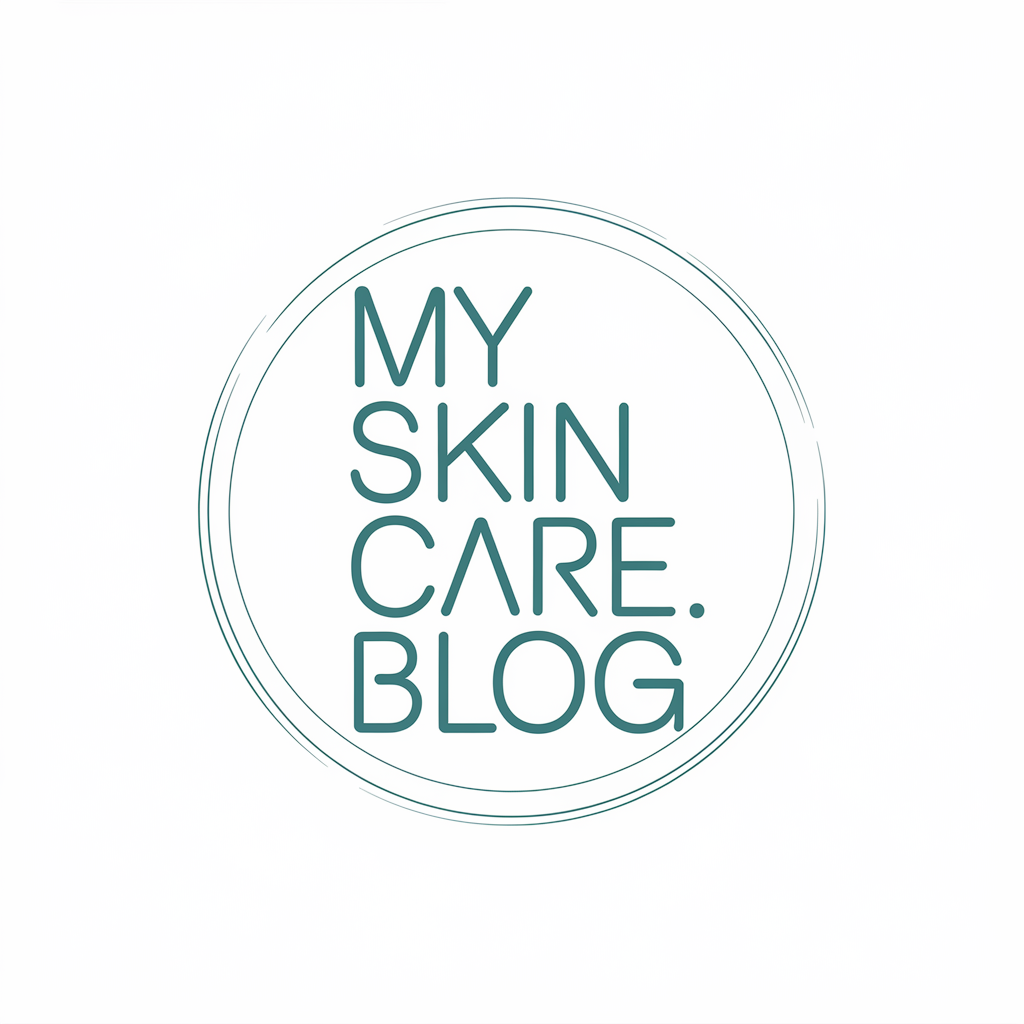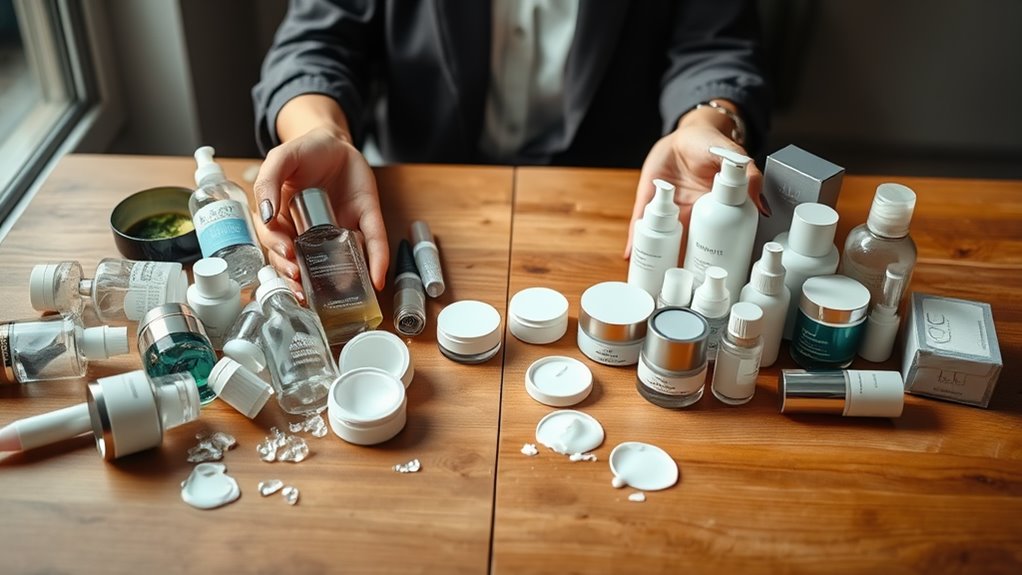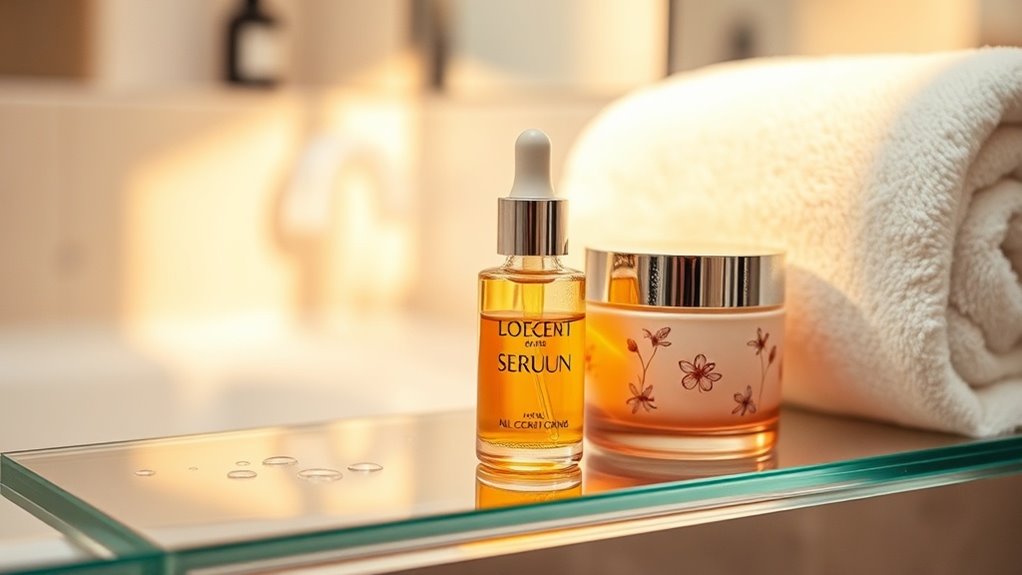Stop Wasting Money- Pick the Right Skincare With This Guide
Stop wasting money on ineffective skincare by first assessing your skin type—check oil levels and texture daily to classify it accurately. Identify concerns like acne or dryness, then select products with proven ingredients such as hyaluronic acid for hydration or niacinamide for barrier repair. Always evaluate labels for active concentrations, perform patch tests, and compare prices to fit your budget. Explore these strategies further to transform your routine.
Key Takeaways
- Determine your skin type through daily observation to match products effectively.
- Examine your skin regularly for concerns like acne or redness to identify triggers early.
- Select products with proven ingredients like hyaluronic acid for targeted, research-backed results.
- Patch test new items and verify labels for key concentrations to avoid irritants and waste.
- Compare prices across retailers and evaluate cost-effectiveness to stay within your budget.
Understanding Your Skin Type
Understanding your skin type is the foundation of effective skincare routines. You assess whether your skin is oily, dry, combination, normal, or sensitive by observing oil production, moisture levels, and texture daily.
This classification drives precise product matching, ensuring you select formulations tailored to your specific needs, like lightweight, non-comedogenic options for oily types.
By focusing on product matching, you optimize ingredient compatibility, enhancing efficacy and longevity of results. For oily skin, controlling excess sebum production is essential to maintain a balanced complexion.
Additionally, explore little-known testing methods to accurately determine your skin type at home using professional techniques.
Identifying Common Skin Concerns
How can you identify common skin concerns like acne, hyperpigmentation, or sensitivity? Start by examining your skin daily in good lighting to spot early signs, such as inflamed bumps for acne, dark patches for hyperpigmentation, or redness for sensitivity. This practical approach empowers you to act quickly. Furthermore, incorporating proper cleansing techniques can help address these concerns by avoiding common mistakes that lead to breakouts.
-
Observe symptoms closely: Scan your skin for texture changes, like oily breakouts or dry irritation, to categorize the issue accurately.
-
Track patterns over time: Note when concerns flare up, such as after sun exposure or stress, to understand their triggers and frequency.
-
Assess severity: Evaluate if the problem is mild and manageable or persistent, indicating a need for professional input to avoid escalation.
Additionally, consider how everyday habits might be contributing to acne by unknowingly aggravating your skin through routines like improper cleansing or dietary choices.
Essential Ingredients for Effective Skincare
While you’ve identified your skin concerns, essential ingredients form the backbone of any effective routine, targeting specific issues with proven efficacy.
You need hyaluronic acid for deep hydration, boosting moisture retention in dry skin.
Retinol actively reduces wrinkles by promoting cell turnover, while salicylic acid clears pores and fights acne bacteria. Additionally, retinol helps achieve radiant skin by enhancing cell turnover and addressing various concerns like fine lines and uneven texture.
Niacinamide strengthens your skin barrier, minimizing inflammation and evening tone.
Always choose formulations with these actives at effective concentrations—think 0.5% retinol or 2% salicylic acid—for real results without irritation.
Prioritize science-backed options to optimize your regimen efficiently.
For optimal results, ensure your routine includes ingredients tailored for different skin types to address specific needs effectively.
How to Evaluate Product Labels
When you’re evaluating skincare product labels, first spot key ingredients that align with your skin’s needs and avoid potential irritants.
Next, verify the claims on the packaging by cross-referencing them with scientific evidence to ensure they’re legitimate.
Finally, check for reliable certifications that confirm the product’s quality and safety standards. Be aware of marketing tactics that brands often use to conceal misleading information.
Additionally, consider concentration percentages to determine if the active ingredients are present in effective amounts.
Ingredients to Spot
Ever wondered which ingredients truly benefit your skin?
When evaluating product labels, you must identify science-backed ones that target your concerns without causing harm.
Focus on these key ingredients to make smarter choices:
-
Antioxidants: Seek vitamin C or E; they neutralize free radicals, reducing signs of aging and environmental damage.
-
Humectants: Prioritize hyaluronic acid; it draws moisture into your skin, enhancing hydration and elasticity.
-
Soothing agents: Look for aloe vera or niacinamide; they calm inflammation and strengthen your skin’s barrier for better resilience.
Claims to Verify
To verify claims on skincare product labels, you must scrutinize them against scientific evidence, checking for terms like “clinically proven” or “dermatologist-tested” by seeking supporting studies or certifications. Don’t just accept buzzwords—demand data from reliable sources like journals or trials to ensure efficacy and safety.
| Claim Type | How to Verify |
|---|---|
| Clinically Proven | Cross-check for peer-reviewed studies |
| Dermatologist-Tested | Look for described testing methods |
| Natural Ingredients | Confirm with ingredient databases |
| Hypoallergenic | Seek evidence of allergy assessments |
Certifications to Check
Beyond the claims on skincare labels, you should scrutinize key certifications to ensure product safety and efficacy.
These third-party validations confirm ingredient integrity and ethical practices, helping you avoid misleading products.
-
USDA Organic: Verify this seal for at least 95% organic ingredients, reducing synthetic chemicals and pesticide exposure while promoting sustainability.
-
Leaping Bunny: Check it to confirm no animal testing, ensuring your choices align with cruelty-free standards and ethical manufacturing.
-
EWG Verified: Look for this mark, as it indicates rigorous testing for low toxicity, helping you select products free from harmful substances like parabens or phthalates.
Matching Products to Your Budget
When you’re selecting skincare products, start by assessing your budget limits to ensure you allocate funds wisely without overspending.
Next, compare product prices across brands to identify cost-effective options that meet your needs.
This approach helps you make informed, practical choices that balance quality and affordability.
Additionally, explore drugstore skincare options that deliver premium results similar to luxury brands.
For optimal results, always consider your skin type when evaluating budget-friendly choices.
[LIST OF 3 SUBHEADING DISCUSSION POINTS IN ENGLISH
Matching skincare products to your budget requires a strategic approach to ensure effectiveness without overspending. It’s crucial to balance quality with affordability, focusing on long-term value for your skin’s health.
To guide you effectively:
-
Assess your skin needs first: Identify your type and concerns, like sensitivity or aging, to prioritize essential, budget-aligned ingredients backed by research.
-
Compare costs and benefits: Evaluate price per ounce and active ingredient concentrations, selecting products with proven clinical efficacy to maximize returns on investment.
-
Opt for versatile options: Choose multi-functional items, such as a moisturizer with SPF, to cover multiple needs without exceeding your financial limits.
Assess Budget Limits
Assessing your budget limits is the first step in smart skincare shopping, as it helps you align product choices with your financial reality.
Start by tracking your monthly expenses to identify disposable income for skincare. Calculate a realistic limit based on essentials like cleansers and moisturizers, prioritizing efficacy over luxury.
Consider long-term costs, such as product longevity and refill options, to avoid overspending. Use budgeting tools to monitor allocations, ensuring you’re investing in items that fit your needs without straining finances.
This approach promotes sustainable habits, preventing regret and waste in your routine.
Compare Product Prices
Once you’ve assessed your budget, compare product prices systematically to find the best fit for your needs.
You’ll evaluate cost-effectiveness by examining ingredients, sizes, and brand reputations, ensuring you’re not overpaying for similar benefits. This approach minimizes waste and maximizes value.
-
Research multiple retailers: Check online stores, pharmacies, and official sites for price variations, using tools like price trackers for accuracy.
-
Assess unit costs: Divide total price by quantity (e.g., ounces) to compare true value, helping you spot deals on bulk options.
-
Factor in extras: Consider shipping fees, promotions, and subscription discounts to calculate the final cost, ensuring long-term affordability.
Building a Personalized Skincare Routine
How can you craft a personalized skincare routine that suits your unique needs? Start by assessing your skin type—oily, dry, combination, or sensitive—and identifying concerns like acne or aging through self-evaluation or a dermatologist’s input.
Select products backed by science, such as niacinamide for brightening or peptides for firmness, ensuring they match your goals.
Build a simple sequence: cleanse to remove impurities, apply treatments, moisturize for barrier support, and add sunscreen for UV protection.
Track your skin’s response weekly and adjust ingredients precisely for long-term efficacy. Additionally, explore comprehensive analyses of popular products to ensure you’re getting the best value for money.
To make smart choices, evaluate the price-to-value ratio of products to balance cost with effectiveness.
Signs of Ineffective Skincare Products
What signs suggest that your skincare products aren’t delivering results? Identifying these indicators helps you avoid ongoing frustration. Pay attention to these practical signs to reassess your routine.
-
Persistent issues: If acne, dryness, or wrinkles remain unchanged after consistent use, your products likely aren’t effective.
-
No visible improvements: Lack of enhanced skin texture, tone, or hydration after the recommended period signals ineffectiveness.
-
Adverse reactions: Increased irritation, redness, or breakouts indicate incompatibility, rather than benefits.
Act promptly to prevent wasted resources. (99 words)
Tips for Proper Product Testing
Before you apply a new skincare product, conduct a patch test on a small area of your skin to detect potential allergies.
Track any reactions, such as redness or irritation, for at least 48 hours to assess safety.
This method helps you make informed choices that protect your skin’s health.
Patch Test
When you’re introducing a new skincare product, conduct a patch test to identify potential allergies before full application. This scientifically backed method prevents irritation and ensures safe use.
-
Select a test site: Choose a small, inconspicuous area like your inner forearm or behind your ear for accurate sensitivity detection.
-
Apply the product: Dab a pea-sized amount on the site and leave it undisturbed for 48 hours to allow reactions to develop.
-
Evaluate the area: Check for any immediate or delayed signs of irritation, such as redness or swelling, to gauge compatibility.
Adopting this practical step empowers you to choose products confidently, minimizing risks effectively.
Track Reactions
After conducting a patch test, you monitor reactions closely to identify any issues early.
Begin by examining the test area every 4-6 hours for the next 48 hours, watching for signs like redness, itching, swelling, dryness, or blistering.
Maintain a simple log to record symptoms, including onset time, duration, and severity on a 1-10 scale.
If irritation persists or intensifies, discontinue the product immediately and consult a dermatologist.
This methodical tracking prevents allergic responses, ensures product compatibility, and avoids wasteful purchases.
Comparing Natural and Synthetic Options
While natural ingredients in skincare often derive from plants and minerals with minimal processing, synthetic options are engineered in labs for enhanced stability and targeted efficacy.
You must weigh these based on your skin’s needs, as naturals offer purity but synthetics deliver precision. Here’s how to compare effectively:
-
Purity vs. Consistency: Naturals reduce allergy risks but vary in potency; synthetics ensure uniform results for reliable outcomes.
-
Efficacy and Shelf Life: You get targeted benefits from synthetics, which resist degradation, while naturals provide gentle, eco-friendly effects.
-
Skin Compatibility: Test synthetics for sensitivity if you have reactive skin; naturals suit you if you prefer organic sources, minimizing irritants.
Finding Affordable Skincare Alternatives
How do you identify affordable skincare alternatives that deliver real results? Start by evaluating ingredient lists for science-backed actives like hyaluronic acid for hydration or benzoyl peroxide for acne, using databases like PubMed.
Compare formulations to pricier brands via apps that analyze efficacy and cost-per-use. Seek generics from reputable sources, ensuring similar concentrations through independent reviews and clinical data.
Don’t overlook sales or subscriptions to cut costs, but always patch test for sensitivity. Tailor choices to your skin type, prioritizing products with verified third-party testing.
This strategy helps you achieve effective results without overspending.





